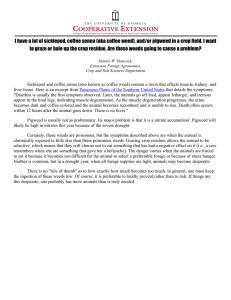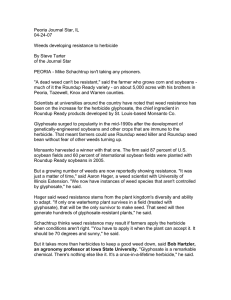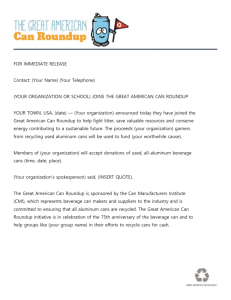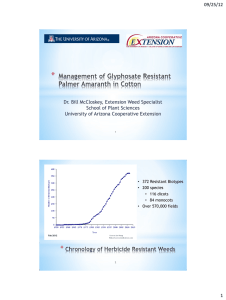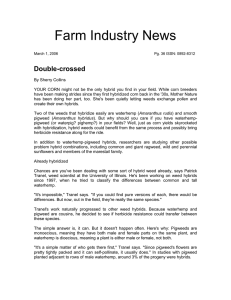I The Unstoppable Seed
advertisement
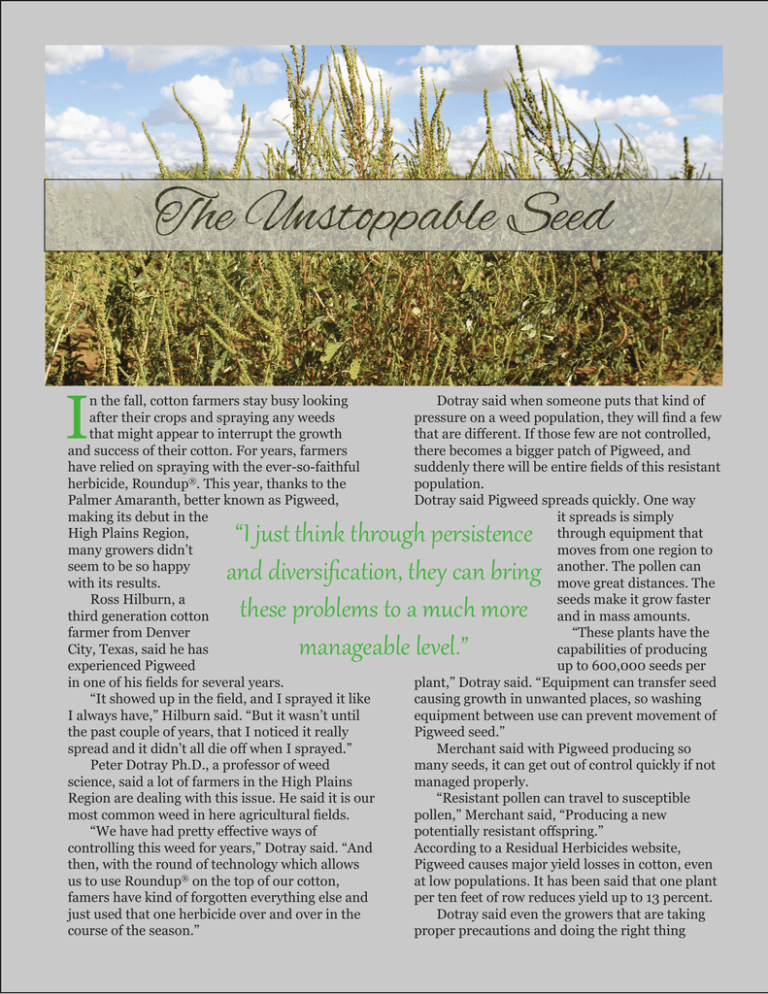
The Unstoppable Seed I n the fall, cotton farmers stay busy looking after their crops and spraying any weeds that might appear to interrupt the growth and success of their cotton. For years, farmers have relied on spraying with the ever-so-faithful herbicide, Roundup®. This year, thanks to the Palmer Amaranth, better known as Pigweed, making its debut in the High Plains Region, many growers didn’t seem to be so happy with its results. Ross Hilburn, a third generation cotton farmer from Denver City, Texas, said he has experienced Pigweed in one of his fields for several years. “It showed up in the field, and I sprayed it like I always have,” Hilburn said. “But it wasn’t until the past couple of years, that I noticed it really spread and it didn’t all die off when I sprayed.” Peter Dotray Ph.D., a professor of weed science, said a lot of farmers in the High Plains Region are dealing with this issue. He said it is our most common weed in here agricultural fields. “We have had pretty effective ways of controlling this weed for years,” Dotray said. “And then, with the round of technology which allows us to use Roundup® on the top of our cotton, famers have kind of forgotten everything else and just used that one herbicide over and over in the course of the season.” Dotray said when someone puts that kind of pressure on a weed population, they will find a few that are different. If those few are not controlled, there becomes a bigger patch of Pigweed, and suddenly there will be entire fields of this resistant population. Dotray said Pigweed spreads quickly. One way it spreads is simply through equipment that moves from one region to another. The pollen can move great distances. The seeds make it grow faster and in mass amounts. “These plants have the capabilities of producing up to 600,000 seeds per plant,” Dotray said. “Equipment can transfer seed causing growth in unwanted places, so washing equipment between use can prevent movement of Pigweed seed.” Merchant said with Pigweed producing so many seeds, it can get out of control quickly if not managed properly. “Resistant pollen can travel to susceptible pollen,” Merchant said, “Producing a new potentially resistant offspring.” According to a Residual Herbicides website, Pigweed causes major yield losses in cotton, even at low populations. It has been said that one plant per ten feet of row reduces yield up to 13 percent. Dotray said even the growers that are taking proper precautions and doing the right thing “I just think through persistence and diversification, they can bring these problems to a much more manageable level.” by using a variety of herbicides and not strictly Roundup® are still experiencing Pigweed show up on their farms. “I think the reason we have run into this problem is because folks have moved away from tillage,” Dotray said. “When you move away from the tillage, you move more and more toward herbicides. Folks should consider tillage in addition to an effective herbicide.” Rand Merchant, a Ph.D. student in Plant and Soil Science who is conducting research on weed resistance under Dotray’s supervision, said his research started around ten years ago when he worked as a consultant in South Georgia and started working with resistant Pigweed in grower’s fields. There he was given the opportunity to work for Stanley Culpepper, a professor at Georgia who first documented resistant Pigweed. “Pigweed is native to the deep Southwest and Sonoran Desert and has moved East for the past 30 years,” Merchant said. “It was never considered a big issue in the 90s because we were able to use Roundup®. It was confirmed to be Roundup® resistant in 2005.” Merchant said Pigweed is native to an extremely dry environment; however, it can successfully grow and grew up to ten feet tall in an environment where it rains a lot. Dotray said he knew Pigweed was growing in the Southeastern states but it was not until August of 2011, that he first found some fields that looked a little suspicious. “We collected some seed, brought it back in the greenhouse and made our own sprays with extremely high rates of Roundup®,” Dotray said, “And it didn’t phase them at all.” Dotray said Roundup® is still a good product and it is useful for a lot of weeds. “Roundup® to me is still going to be an effective herbicide because we don’t just have Pigweed out in our fields,” he said. “We have a variety of types of weeds and Roundup® is still very good on those.” Dotray said there will hopefully be a new product on the market in the near future, but it is vital to find other options of herbicides since this weed is affecting the future success of the cotton. “Pigweed is very competitive with cotton,” Dotray said. “In this region where the water is limited, we would like it all to go to the cotton and not have a weed taking it all.” Merchant said right now the biggest challenge with his research, is focusing on taking available chemistries and finding the balancing point between getting effective control, while at the same time, keeping it economical. He said the more economical they keep it, the more farmers will adopt it. Dotray said the appearance of resistant Pigweed is unfortunate, but he does not believe it will go away. It is now about finding a way to control it. Some farmers get panicked about it, while others ride it out and keep a calm approach. He believes it will be overcome and that it is not the first resistant plant to come about, and it will not be the last. “I think in the past they’ve heard discussions about resistance and maybe they didn’t pay real close attention,” Dotray said, “But once it happens on their farm, it’s a different story, and I just think through persistence and diversification, they can bring these problems to a much more manageable level.”
